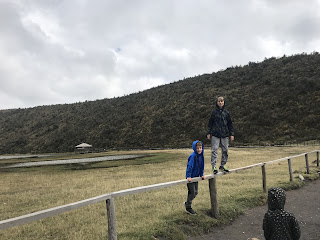Cotopaxi National Park
On our way home from Quito last week, we stopped over at Cotopaxi National Park, a place I always wanted to visit but never had, even though the entrance lies just 31 miles south of Quito and is essentially on the way home to La Josefina.
Cotopaxi, a perfectly symmetrical snow-capped stratovolcano, is the second highest peak in Ecuador at 19,347 feet (5,897 meters) and forms part of a region nicknamed the Avenue of Volcanoes. It is among the world's tallest active volcanoes (I always thought it WAS the world's tallest active volcano, but apparently that is up for debate). Cotopaxi means "neck of the moon" in Kichwa, a name that is believed to refer to the crescent shape of its massive crater (800 m x 550 macross, 250 m deep).
Records show a total of 87 historic eruptions. The nearby city of Latacunga (where we catch our bus to head down the Andes to La Josefina) was totally destroyed three times -- in 1744, 1768, and 1877. Cotopaxi last erupted in 2015, emitting copious ash and 20,000 tons of sulfur dioxide per day. The volcano, national park and much of the surrounding area was closed for over a year.
Interestingly, the day before we arrived, the slumbering volcano threw off a good amount of vapor, followed by ash, and the national park was immediately closed. Climbers, guides, and park staff were removed urgently from the mountain in the middle of the night. I am sure they were not pleased, though someone later described the potent sulfur smell in the air as a compelling enough warning.
We thought we might have to return another day to enter the park, but then an experienced guide with close ties to the hostel where we were staying, found out that, with special permission, guides would be allowed to bring tourists into the park only up to a certain elevation. Lucky for us, most visitors didn't have this privileged information and stayed home. Basically, this meant that even on a Sunday morning, we had the national park to ourselves. Literally.
The morning turned out to be beautiful. We completed a lovely hike around Lake Limpiopungo, spotting a few new Andean birds and lizards amidst striking terrain and views of neighboring Volcano Ruminahui, and then our guide, Francisco, drove us up to the road closure at 4900m, where Cotopaxi behaved very nicely and showed off, not only his cone but with a big puff of ash. It felt like a private viewing.
I love national parks.
***
On a completely separate note, Paul found a lovely hostel near the park entrance, and I was reminded how much I LOVE staying in hostels, shared bathrooms and all. Such a great introduction for the kids too. There is nothing like a bit of forced shared space (dining, toilets, sinks and showers) to promote conversation and automatic kinship. We met people from Guayaquil (Ecuador), Germany and Portugal. The kids scored a cozy loft bedroom in the attic, and the breakfast was outstanding. The first night, there was even spontaneous live Andean music in the dining area, and Brynna won a prize for being the bravest and first to start dancing. The owners were lovely and helped us get to the park, and then when we were leaving, the kids got to feed their ducks and llamas.
For anyone considering a visit to Ecuador, the name of the hostel is Hostal Rondador Cotopaxi. I will leave the link to the hostel here.


















Comments
Post a Comment